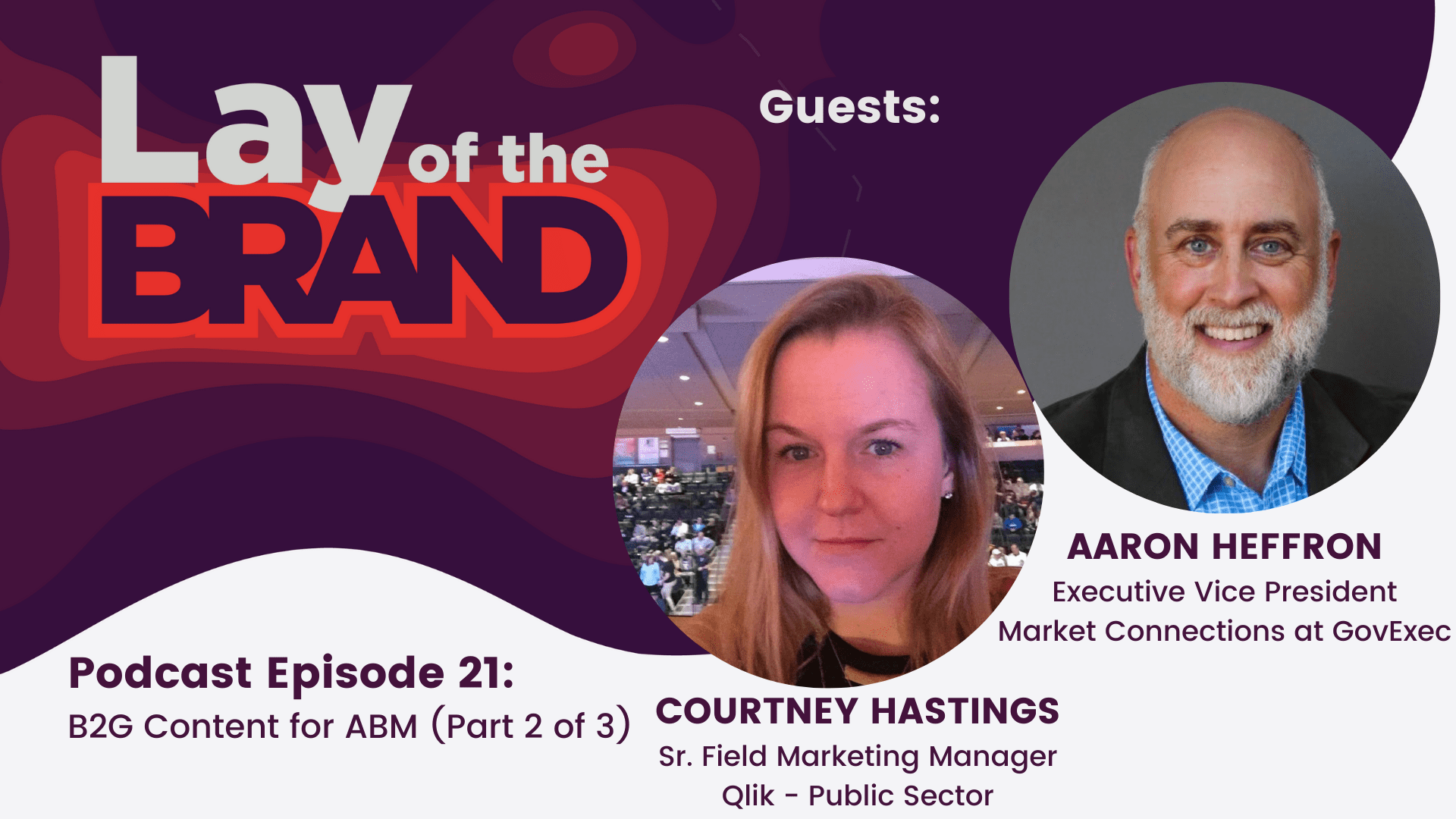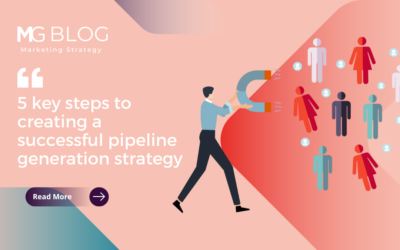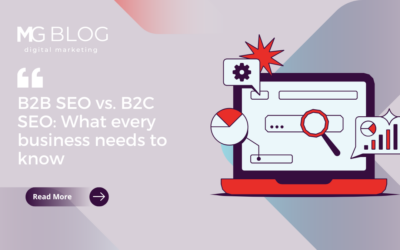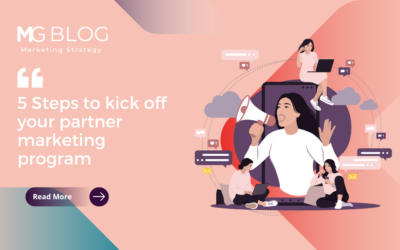
In the second of a three-part series on federal account-based marketing Peter Jacobs of Merritt Group, Aaron Heffron of Market Connections and Courtney Hastings of Qlik discuss how information and data can inform content strategies and how messaging, collateral and placement should be adapted to focus on the target audience you are trying to reach.
Here are the highlights of our conversation. Click below to listen to the podcast or visit layofthebrand.com.
For a free download of “Understanding Agency Needs for Account-Based Marketing Efforts,” click here.
Mapping a content strategy for account-based marketing
Peter Jacobs, Lay of the Brand: ABM (account-based marketing) campaigns are a combination of content, collateral and creative. How do you go about mapping an effective content strategy?
Courtney Hastings, Qlik: I find it easier to develop a content strategy with account-based marketing programs than other campaigns we might be executing to a broader audience. With account-based marketing, you already know what agencies you’re going after. So it’s just about identifying who are your decision-makers, who are your influencers and who are your end-users. From there you can dig into what are the various topics, tactics, and creative approaches that will speak specifically to those audiences.
Peter Jacobs, Lay of the Brand: What sorts of things have you done to deliver value to your sales teams?
Courtney Hastings, Qlik: Not to promote my podcast on your podcast, but we recently launched one at Qlik (called Data Reveal). It’s me and a couple of members on the federal team talking about what’s going on in the world and about how data influences it or comes from it. We realized early on that we were able to use that venue to address very specific issues that were affecting one or a few of our customers.
For example, we had a podcast recently where we brought on an expert in domestic violent extremism, which we knew was a major concern for the Department of Homeland Security through our conversations with them. Just through sharing that podcast with a couple of individuals at the DHS, the sales team was able to find inroads and get some meetings.
Data to inform your content strategy
Peter Jacobs, Lay of the Brand: Let’s talk about the data that you use to inform content. It’s more than just raw information. It’s the knowledge you can glean from data too, correct?
Aaron Heffron, Market Connections: Everything we interact with creates a data point out there. Sometimes it’s a conversation that your salespeople or your marketing person has. Sometimes it’s the information you’re getting from the interactions on your website and downloads. Sometimes it’s the sales and contract information that comes out, where other companies are engaging and there’s new budget information coming in. And then there’s all the environmental data out there, with trends moving in certain directions.
It’s really this stew of data that gets mixed around. You start to try to dole it out to everybody in bowls and it’s disparate. I mean, we’ve all gotten the bowl of stew that has the one piece of shrimp in it and the person next to you gets 10 pieces. You’re like, “Well, that doesn’t seem quite fair.” But it’s all in how data was combined, mixed and interpreted along the way. I spend a lot of time with our clients trying to take all these disparate pieces of information and make them useful and relevant. That way everybody gets their two or three pieces of shrimp, and nobody’s left hungry.
Peter Jacobs, Lay of the Brand: Time is a huge part of this because there are only so many hours in the day, and so much information. How do people deal with absorbing all that and then turning it into actionable content?
Aaron Heffron, Market Connections: I liken to thinking about narrowing it down to the particular individuals that are important to you as a marketer, as a salesperson, who’s important in the conversation—then understanding all we can about that person, as an individual, while also looking at where the commonalities are across the individuals. We don’t have unlimited resources and unlimited time, so I like to start by looking for commonalities because that’s where you’re going to get your biggest return.
“Here are five different agencies. Here are five different types of people. Let’s figure out what’s the same about them first.”
Once we figure out what’s the same about them, to Courtney’s point, you can start your planning and you can create the campaign based on those commonalities. Then the ABM side of things is layered on top of that, where you can tailor particular messages, outreach strategies, etc., that lay on top of that common strategy.
Considering personas for your ABM content strategy
Peter Jacobs, Lay of the Brand: When you’re approaching ABM content throughout your campaign for the different personas that you’re dealing with, how do you change your strategies? Are there different ways that you’re going to talk to a mission leader versus a technical leader in terms of the content, the channels, the approach?
Courtney Hastings, Qlik: Yes, absolutely. As I alluded to previously, different personas respond to different messages, different creative and different tactics. It’s important when you’re building an ABM program that you are addressing each of those audiences and meeting them where they are. So an example recently is, we were building a campaign around the launch of our new SaaS product for the federal government. We realized there was going to be a completely new audience for us, someone that we didn’t really work with regularly (CDOs and CEOs). We already knew that our end-users care about content around speed and scale. But for the CISOs, which would be a key influencer, it was about security. And that is not a message that we’ve used before. So we really had to lean in and create the creative around that and figure out how to reach them.
I loved what Aaron said before, particularly for the public sector. Identifying the commonalities is a big deal because it’s hard. Being able to find where a message for the federal office audience will also work for the state and local audience or healthcare audience is something I try really hard to do so I can make my resources go as far as possible.
Aaron Heffron, Market Connections: The interesting part of that is that sometimes the commonalities are less technical and more personal to the individuals. As we interviewed and surveyed federal, state and local and other types of entities, we find that they really want to feel like they’re making a difference in what they’re doing every day. They’re very mission-focused.
That starts to lay the groundwork for that messaging and conversation that you’re having. The technical stuff of what this technology does can be plugged in at a lot of different pieces, but the connection to how that technology or that product helps them as an individual within their agency— I make sure that I can communicate. That’s the commonality.
We have so many clients that come to us and say, “Tell me where this technology fits within all these different agencies.” And I’ll go, “Well, let’s back up just a little bit. Let’s figure out what it is that this technology does for the individual sitting in this agency, more so than what it does for the agency at large.”
Peter Jacobs, Lay of the Brand: That’s something that a lot of marketers often have to deal with. It’s getting beyond the “what the thing does” and more about the “why it’s necessary, why it makes a difference and how it’s to make a positive change.” And as you’ve both said here, there needs to be an emotional connection to it.
Courtney Hastings, Qlik: I was just going to add to that. It’s part and parcel of the same thing that Aaron was saying. As a technology provider, we focus really hard on establishing relationships. And that’s a big part of something we haven’t talked about today in regards to account-based marketing. To Aaron’s point, these people really do focus on the mission.
“When we approach them, it’s not about shoving our technology in their face, but it’s about having the conversation of “what are the problems that you are facing with your agency.” If you’re using particular technologies, how are those working out for you?”
What can we do, as Aaron said, to support you in your specific job? We have those conversations every day.
Reaching your target audience with content
Peter Jacobs, Lay of the Brand: It isn’t just a one size fits all kind of approach: We need to have a white paper, we need to have a webinar, or we need to have these three pieces of collateral and we update the landing page and boom, we’re done. ABM.
Aaron Heffron, Market Connections: The different types of collateral and different ways to reach individuals varies greatly by the type of person and the role that they play. Even the generation that they sit in. We have found that on average, the state and local individuals are about 10 years younger than the federal government person that sits in there. So that’s an entire generation difference in how they get information, how they interpret information.
“We’ve found that the federal folks like to sit and read something for 15-20 minutes. So that’s the optimal length of a white paper. The state and local person is more likely to spend 15-20 minutes watching something.”
And that’s part and parcel to some of the generational differences that you see.
We heard a story from one of our clients about the most popular video they did. They took an engineer and had him sketch out on a whiteboard describing how something worked. And it was incredibly popular and it got more views and more hits on that than any of the slickly produced videos they had done to that point because it hit on two of the elements that we find that everybody wants. One is lots of information and detail that is incredibly useful and direct and clear. And two, it has no real sales message to it; it just sounds like I’m being taught.
Courtney Hastings, Qlik: People really want to get value in the things that they invest in watching. And we’ve seen some similar successes where, rather than us providing a one-minute corporate produced video for an event, having our sales member just addressing the audience or sending them a video of one of our technical folks doing a demo they recorded themselves on their computer.
Adapting your strategy for the next normal
Peter Jacobs, Lay of the Brand: Going forward, how will marketers adjust their outreach strategies when they realize they may not be in the room with somebody?
Aaron Heffron, Market Connections: That’s what everybody’s struggling with right now. Some people are finding it useful to be places that they wouldn’t otherwise be able to get to. The upside is that I can hold a meeting and have folks in eight different locations all around the country and everybody is pretty tolerant of doing it virtually. Everybody takes it with a grain of salt, and it doesn’t have to be perfect because this is another means to communicate and get the information across. There’s a lot of sales ops people and VPs of sales who are looking at their budgets and numbers and going, “Well, you made your numbers last year and we didn’t have to spend all that money of you walking the floors and having dinners and doing all that sort of stuff, and stuff still seemed to happen.
Just to do my own little promotion, we’re releasing the findings from our 2021 media study for how the feds are consuming information: what types of media they go to: radio, TV, events, digital. In 2021, I’m seeing as re-establishing an equilibrium, to some extent. We’re not going to get back to where we were in 2019. Too much has happened, too many shocks to the system, too many implementations of new technologies.
The big question for all of us will be, “where does it settle?” As everybody makes their plans, their marketing and BD plans going forward, the question is, “how do we allocate our resources in this little bit of a different world?” I think there’s going to be an equilibrium where we’re allowed to try and do some things that are a little bit different. There’s greater permission to take risks because the cost and barriers are lower than they were.
“It’s actually a great time for marketers and the creativity that you can bring to the table because you’re not going to be bound to the quote, ‘tried and true.’”
You can roll dollars into something that’s a little bit new and different.
Courtney Hastings, Qlik: Bringing it back to content, it was very early March of 2020 and I was set to fly out on Monday to the biggest healthcare IT conference. I found out before that weekend even started that it was canceled. Within the next couple of weeks, we were tasked with completely redoing our plans and our budgets for the year because we knew that that change was coming. And for me, I reinvested all of those dollars into content campaigns.
I think the other thing to consider is that we’ve gotten comfortable in these environments, but we’ve definitely seen virtual conference attendance (lag). People’s attention spans are getting pretty short.
“We have to make sure that the content we’re providing is really adding value and is bringing them into the environments that they want to be in.”
Moving forward: Information key to planning
Peter Jacobs, Lay of the Brand: Any last thoughts for marketers as they build out their content for their ABM campaigns?
Aaron Heffron, Market Connections: Making the investment in understanding the thoughts and direction of the customers that you’re trying to target and making sure you have a clear understanding before you leap into the next step is going to be even more important than it was. The more relevant that you can be, the more directive you can be — in not only what you’re delivering, but how you’re saying it and how you’re delivering it — is going to be essential. You’ve got to make sure that your content stands out in a way that maximizes the connection to the individual and makes the best use of their time. Because you’re asking them to spend a little bit of their time capital in engagements with you well before you’re asking them to spend their dollars with you. Sometimes that time is even more valuable than the dollars.
Courtney Hastings, Qlik: I work for a data company, so it is all about the data for me. And quite frankly, I think that it’s a very useful tool for marketers because it makes it easier to make your decisions. It makes it easier for you to justify your decisions, and it makes it easier for you to communicate about those to the sales organization.
If particular things are working or messages are resonating, then the data’s going to indicate that for the most part. That being said, the data doesn’t always tell the whole story— sometimes we know anecdotally that someone really liked a white paper. Industry trends are more important than ever because we are navigating new territories. It’s important to see what your campaigns are producing and then to use that data to go into these campaigns, leveraged with industry trends. But also, be creative and have fun. We’re in unprecedented territory, let’s see what 2022 has to offer and what we can make of it.
Want to learn more about how to reach government decision-makers? Listen to the first episode of this 3-part podcast series and other episodes at layofthebrand.com on your favorite streaming platform and check out our B2B Marketing Hub.
For more information on Market Connections: https://www.marketconnectionsinc.com/
For more information on Qlik: https://www.qlik.com/us/



